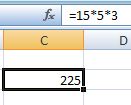MATHEMATICAL OPERATIONS
We have seen how data ranges are added with Excel as well as specific quantities located in different cells.
We can also use basic operations in Excel: adding (sum), subtracting, multiplying, and dividing. In the same way as in regular mathematics, we must be careful of laws and rules for each one of these operations.
Adding
1) We select the cell in which we want to sum (add).

2) We write the equal sign (=), as we have seen in previous lessons, to perform operations.

3) And we start writing down the numbers we want to add.

Lets see our formula bar. It tracks the information being written in the cell.

4) We press Enter on the keyboard, and our sum will be complete.

We can see how the cell presents the result of the sum, the formula bar shows every step of the operation in detail.
Multiplying
a)We select the cell in which we want to multiply

b) We write the equal sign (=), followed by the numbers we want to multiply.

Remember that to multiply, we must use the asterisk symbol (*)
Lets see our formula bar.

c)We press Enter on the keyboard, and our operation will be complete.

Dividing
1) On the cell we want to perform our division, we write EQUAL (=), and the numbers to be divided.

Our formula bar tracks the information being written in the cell.

2) We press Enter on the keyboard, and we will get our result

Remember that if we want to perform combined operations, mathematic rules must be followed in Excel.
For example, if we wish to perform the following operation: 4*5*(20/4),
First, we need to perform the operation inside the parentheses to be able to continue with the other operations. In the end, we would have: 4*5*5
Elevating to the power of...
To elevate a number to the power of another number (a number multiplied by itself a certain number of times), we follow the same steps as the rest of the operations presented so far. Remember that the symbol for power is "^". For example, if we want to elevate 3 to a power of 4, you would do the following:
= 3^4, which will give us a result of 81.
(3 x 3 = 9 x 3= 27 x 3 = 81)

